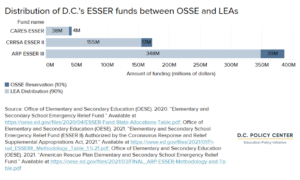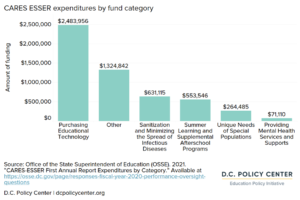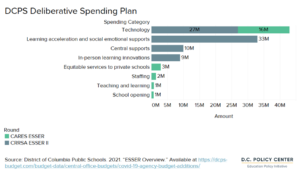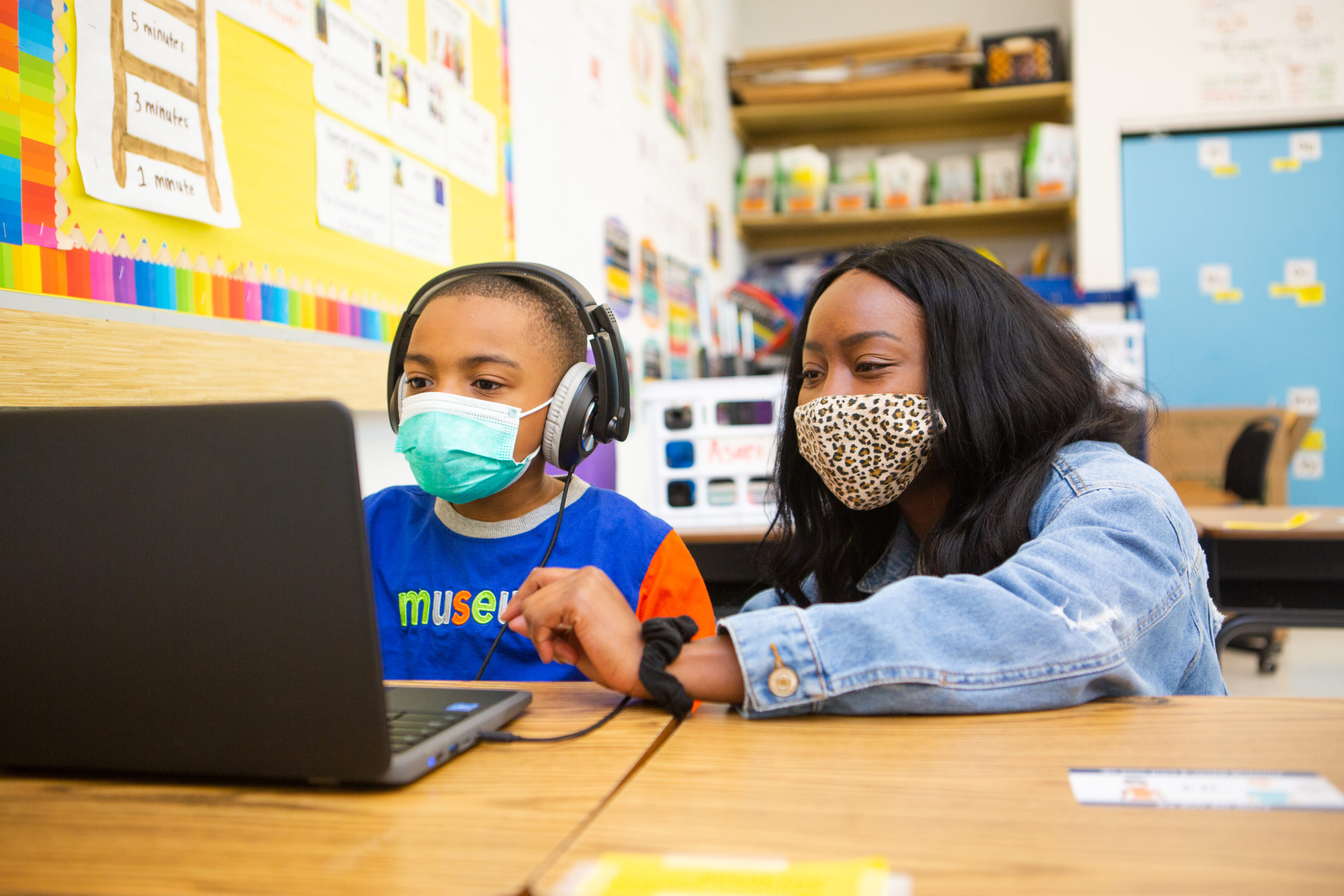To help schools and students cope with the extreme challenges created by COVID-19, the U.S. Department of Education awarded three rounds of Elementary and Secondary School Emergency Relief (ESSER) funds. These grants were given to states to assist schools and Local Education Agencies (LEAs) in addressing the impacts of COVID-19 on elementary and secondary education and enabling disadvantaged students to fully participate in school activities.[i]
The first of the federal ESSER funds was authorized as part of the Coronavirus Aid, Relief, and Economic Security (CARES) Act in March 2020.[ii] ESSER II funds to address education disruptions caused by COVID-19 were included in the Coronavirus Response and Relief Supplemental Appropriations (CRRSA) Act in December 2020, and ESSER III funds followed in the 2021 American Rescue Plan (ARP) Act.[iii] D.C.’s Office of the State Superintendent (OSSE) is in the process of completing its ESSER III (ARP) state plan, and schools in D.C. are currently submitting their application assurances[iv] to receive part of their preliminary allocation amount.
OSSE and schools in the District will receive $600 million across the three ESSER fund distributions, with more than half of the funds ($386 million) expected in the third installment. LEAs (DCPS and public charter schools) will receive 90 percent of the total funds, with allocations based on Title 1 formulas to reach more students living in low-income households. OSSE will receive the remaining 10 percent.[v] CARES ESSER funds are available for use until September 30, 2022, CRRSA ESSER II funds are available for use until September 30, 2023, and ARP ESSER III funds are available for use until September 30, 2024.[vi]

OSSE outlined possible uses for the funds including paying for new learning resources, increased sanitation, or expanding existing federal programs for disadvantaged students, but LEAs have substantial flexibility on expenditures.[vii] Between March and September of 2020, D.C. LEAs reported that they already spent $5.3 million out of the $37.8 million from the CARES Act ESSER fund. Almost half ($2.48 million) was spent on purchasing educational technology to close the digital divide. This investment was necessary: before the pandemic, one in eight D.C. residents did not have access to a computer or tablet, and 24 percent of children lacked access to broadband internet.[viii] Other common uses included sanitization and minimizing the spread of infectious diseases ($631,000) and summer learning and supplemental after-school programs ($554,000).[ix]

DCPS spotlight
District of Columbia Public Schools (DCPS), D.C.’s largest LEA and the recipient of more than 50 percent of D.C.’s LEA funds, has received $22 million from CARES ESSER and an estimated $80 million from CRRSA ESSER II. DCPS’s deliberative spending plan shows that technology is a major spending priority. ESSER II funding also prioritizes spending on learning acceleration and socio-emotional supports.

D.C. expects to receive $386 million in the third round of ESSER grants, with $347.4 million dedicated to LEA spending and $38.6 million for OSSE. Unique to ARP ESSER III, 20 percent of LEA funds and 5 percent of OSSE funds must be spent on addressing learning loss, 1 percent of OSSE funds must be spent on summer enrichment programs, and 1 percent must be spent on comprehensive afterschool programs.[x] Operating on a shorter deadline, OSSE must allocate ARP ESSER III funds to LEAs within sixty days of receipt from the federal government. All LEA funds from ARP ESSER III must be obligated by September 30, 2024.[xi]
D.C.’s schools are currently creating plans on the best uses of these funds and are required to seek broad public input during this process.[xii] Schools can use the ARP ESSER III funds in four broad categories, including academic interventions, transfers, long term investments, and non-academic supports. However, their plans are constrained by the three-year spending limit and the one-time nature of these funds. The $347.4 million of ARP ESSER III funds granted to LEAs to provide for an estimated 87,045 students in pre-kindergarten through grade 12 works out to an average of $4,300 per student over the next three years.[xiii] Suggested short-term interventions by experts across the country include academic supports like a longer school year, intensive tutoring, or summer camps;[xiv] transfers that would allow the recipient–either parents, caregivers, or schools–to choose how to spend on education;[xv] long-term investments in curriculum or modernizing data systems;[xvi] and non-academic supports for social-emotional needs or addressing absenteeism.[xvii]
We reached out to the Deputy Chancellor of DCPS, the President of KIPP DC PCS, and a PAVE parent to ask, “How should schools spend their ESSER funds? What are the most pressing needs of students for recovery over the next three years and how can these funds meet those needs?”
Dr. Amy Maisterra, Deputy Chancellor of DC Public Schools
By asking our community to provide input on potential investments related to school health and safety operations, academic interventions for learning recovery, social emotional learning and mental health supports, professional development for our educators, technology for students and teachers, and family and student attendance and engagement strategies, among others, it will help meet our collective commitment to build back stronger.
DC Public Schools (DCPS) has strategically utilized federal stimulus funds, commonly referred to as Elementary and Secondary School Emergency Relief (ESSER) funds, to support COVID-19 recovery and student and school needs during these unprecedented times.
Between March and December 2020, DCPS received $108 million in ESSER I and ESSER II funds. This includes more than $33 million for student, teacher, and classroom technology, and another $33 million for student learning acceleration and social emotional supports that includes in-person programming at every school this summer. DCPS also uses COVID-19 emergency funds to finance health and safety operational items such as our PPE inventory and allowed for $24 million in HVAC enhancements ahead of school buildings reopening this past year. An overview of DCPS federal stimulus funds is available on our school budget website, DCPSBudget.com.
DCPS is scheduled to receive $191 million in additional ESSER funds via the American Recovery Plan (ARP) to allow the full reopening of schools for in-person learning in the fall. An initial $20 million investment of ARP ESSER funds will ensure no DCPS school experiences a reduction in their Fiscal Year 2022 (FY22) budget compared to FY21 budget levels, and that schools’ immediate budgetary needs are addressed in advance of the next school year. As for the other relief funds available, we are asking our school community to help prioritize these investments. DCPS has a public survey open through May 28 that asks our stakeholders — families, teachers, staff, and school advocates — to guide where ARP funds should go.
As DCPS continues to recover from the pandemic and address factors that contributed to the COVID-19 learning slide, we remain focused on re-envisioning and rebuilding the district through the strategic use of available resources. By asking our community to provide input on potential investments related to school health and safety operations, academic interventions for learning recovery, social emotional learning and mental health supports, professional development for our educators, technology for students and teachers, and family and student attendance and engagement strategies, among others, it will help meet our collective commitment to build back stronger.
We are focused not just on what is next for the upcoming school year, but what is beyond our horizon as a district. For this reason, we are aggressively targeting federal stimulus dollars to fund initiatives that address the academic and social emotional learning impacts of the past year, and we are excited to hear feedback from the community to inform a robust recovery plan which we will then post for public comment.
Allison Fansler, President of KIPP DC Public Schools
An influx of resources and federal funding to support recovery in the wake of COVID will allow us to make important investments to become a more impactful, innovative, and inclusive school system, that provides joyful, identity-affirming learning experiences.
As we look ahead to the next school year, we are inspired by the opportunity to rethink how KIPP DC operates and how to better support our students. If COVID taught us anything, it’s that we can quickly adapt and reinvent ourselves – and that many of the approaches, systems, and traditions that have been part of our culture could be improved. This quote by Dr. Jal Mehta in a New York Times opinion piece this winter really spoke to us: “There has been considerable attention to the health crisis, and some to the economic crisis. But there hasn’t been a serious commitment to the corresponding educational crisis. We need to rebuild and reimagine schools. We now have a chance to do both.”
We are still focused on the same ambition and priorities that we outlined in KIPP DC’s 2025 strategic plan. But the pandemic has further revealed why these priorities – enhancing student learning and experience, amplifying the voices of families and communities, identifying and confronting institutional racism, investing in our people, and cultivating new ideas – are more critical than ever. An influx of resources and federal funding to support recovery in the wake of COVID will allow us to make important investments to become a more impactful, innovative, and inclusive school system, that provides joyful, identity-affirming learning experiences.
We’re approaching our recovery in three phases:
- Reopening to immediately meet the needs of our students and families;
- Reimagining what’s possible and capitalizing upon the opportunity to reset on approaches, systems, processes, policies, and practices; and
- Rebuilding our schools to support students better than before the pandemic.
Most immediately, as part of our reopening efforts, we are investing significant capacity and funding into the following priority areas:
- Hiring additional instructional staff to accelerate learning, provide small-group instruction, and reduce the size of student cohorts per classroom.
- Expanding access to technology to ensure that every student has access to a device at school and at home.
- Ensuring students have access to high-quality summer and out-of-school academic and enrichment programming.
- Building out a virtual program option staffed by remote learning coordinators to support instruction of students who can’t return to school in person yet.
- Prioritizing the staffing, supplies, and procedures needed to ensure a healthy and safe learning environment for students and staff.
KIPP DC is so grateful to the District and federal leaders who have prioritized the recovery efforts of schools. The resources and support that have been made available for our students, families, and communities will have a tremendous impact on our ability to reopen, reimagine, and rebuild schools.
Marcia Huff, PAVE Parent Leader
I want schools to help their students develop tools to manage stress for years to come. One way to achieve this is through enrichment activities such as yoga, meditation, sports, arts, and music.
I have two kids who attend public charter schools and while I want their schools – and all schools in D.C. – to invest in academic interventions such as tutoring and targeted summer programming, I think we need to prioritize investments in emotional wellbeing. Hiring more social workers and psychologists might be beneficial, but as we move forward, I think it’ll be important to remember that investing in mental health doesn’t end with social work and therapy. I want schools to help their students develop tools to manage stress for years to come. One way to achieve this is through enrichment activities such as yoga, meditation, sports, arts, and music. For example, my son’s school is hosting outdoor team building activities that are helping him ease back into social interactions with other students. Investing in these kinds of activities will allow students to practice self-care and cultivate new interests they can turn to for comfort long after they graduate.
As LEAs think more about how to spend ESSER funds, they should take several steps to build trust and foster transparency. They should form advisory committees that include parents, students, and teachers to learn more about how those stakeholders want the funding to be spent. They should also publish spending plans and regular updates to increase accountability and ensure that community-wide goals are being met.
Read more about the impact of COVID-19 in the District of Columbia.
